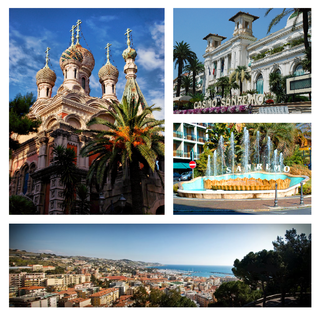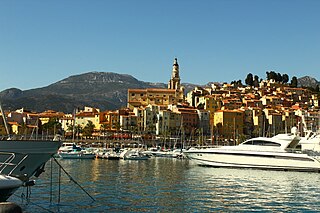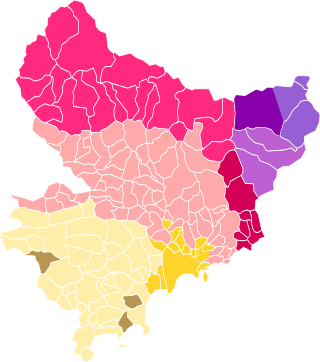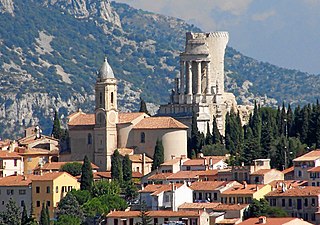
Occitan, also known as lenga d'òc by its native speakers, and sometimes also referred to as Provençal, is a Romance language spoken in Southern France, Monaco, Italy's Occitan Valleys, as well as Val d'Aran in Catalonia; collectively, these regions are sometimes referred to as Occitània. It is also spoken in Calabria in a linguistic enclave of Cosenza area. Some include Catalan in Occitan, as the distance between this language and some Occitan dialects is similar to the distance between different Occitan dialects. Catalan was considered a dialect of Occitan until the end of the 19th century and still today remains its closest relative.

The Italian Riviera or Ligurian Riviera is the narrow coastal strip in Italy which lies between the Ligurian Sea and the mountain chain formed by the Maritime Alps and the Apennines. Longitudinally it extends from the border with France and the French Riviera near Ventimiglia eastwards to Capo Corvo which marks the eastern end of the Gulf of La Spezia and is close to the regional border between Liguria and Tuscany. The Italian Riviera thus includes nearly all of the coastline of Liguria. Historically the "Riviera" extended further to the west, through what is now French territory as far as Marseille.

Sanremo or San Remo is a city and comune on the Mediterranean coast of Liguria, in northwestern Italy. Founded in Roman times, it has a population of 55,000, and is known as a tourist destination on the Italian Riviera. It hosts numerous cultural events, such as the Sanremo Music Festival and the Milan–San Remo cycling classic.

The Principality of Seborga is an unrecognised micronation that claims a 14 km2 area located in the northwestern Italian Province of Imperia in Liguria, near the French border, and about 35 kilometres (20 mi) from Monaco. The principality is coextensive with the town of Seborga; assertions of sovereignty were instigated in 1963 by a local campaigner based on unproven claims about territorial settlements made by the Congress of Vienna after the Napoleonic Wars.

Menton is a commune in the Alpes-Maritimes department in the Provence-Alpes-Côte d'Azur region on the French Riviera, close to the Italian border.

Of the languages of France, French is the sole official language according to the second article of the French Constitution. French, a Gallo-Romance language, is spoken by nearly the entire population of France.

Occitania is the historical region in Western and Southern Europe where the Occitan language was historically spoken and where it is occasionally used as a second language. This cultural area roughly encompasses much of the southern third of France as well as part of Spain, Monaco, and parts of Italy.

Roquebrune-Cap-Martin, simply Roquebrune until 1921, is a commune in the Alpes-Maritimes department in the Provence-Alpes-Côte d'Azur region, Southeastern France, between Monaco and Menton. In 2018, it had a population of 12,824. The name was changed from Roquebrune to differentiate the town from Roquebrune-sur-Argens in neighbouring Var.

Monégasque ; Italian: Monegasco is the variety of Ligurian spoken in Monaco. It is closely related to the Ligurian dialects spoken in Ventimiglia and is considered a national language of Monaco, though it is not the official language of the country, which is French. Monégasque has been officially taught in the schools of Monaco since 1972 and was made a compulsory subject in 1976, but is the native language of only a handful of people.

The Province of Imperia is a mountainous and hilly province, in the Liguria region of Italy, situated between France to the north and the west, and the Ligurian Sea, an arm of the Mediterranean Sea to the south. Its capital is the city of Imperia.
Brigasc is a dialect of the Ligurian language. It is spoken in Italy and France.

Niçard, nissart/Niçart, niçois, or nizzardo is the dialect that was historically spoken in the city of Nice, in France, and in a few surrounding communes. Niçard is a subdialect of Provençal, itself a dialect of Occitan. Some Italian irredentists have claimed it as a Ligurian dialect, on false grounds.

The Gallo-Italic, Gallo-Italian, Gallo-Cisalpine or simply Cisalpine languages constitute the majority of the Romance languages of northern Italy: Piedmontese, Lombard, Emilian, Ligurian, and Romagnol. In central Italy they are spoken in the northern Marches ; in southern Italy in some language islands in Basilicata and Sicily.

Ligurian or Genoese is a Gallo-Italic language spoken primarily in the territories of the former Republic of Genoa, now comprising the area of Liguria in Northern Italy, parts of the Mediterranean coastal zone of France, Monaco, the village of Bonifacio in Corsica, and in the villages of Carloforte on San Pietro Island and Calasetta on Sant'Antioco Island off the coast of southwestern Sardinia. It is part of the Gallo-Italic and Western Romance dialect continuum. Although part of Gallo-Italic, it exhibits several features of the Italo-Romance group of central and southern Italy. Zeneize, spoken in Genoa, the capital of Liguria, is the language's prestige dialect on which the standard is based.

Mentonasc is a Romance dialect historically spoken in and around Menton, France. It is classified as a dialect of Occitan and a sub-dialect of Vivaro-Alpine, with some influence from the neighbouring Intemelian Ligurian dialect spoken from Ventimiglia to San Remo.

La Turbie is a commune in the Alpes-Maritimes department in southeastern France.

The official language of Monaco is French. In addition, there are several other languages spoken, including Italian, English, and Monégasque, the national language of the Monégasque people.

The Genova-Ventimiglia railway runs along the coast of the Liguria region of Italy. It was opened as a single track line between Genova and Savona in 1868, and between Savona and Ventimiglia in 1872, mostly running along a coastal corniche.

Italian irredentism in Nice was the political movement supporting the annexation of the County of Nice to the Kingdom of Italy.
Royasc is a dialect bridging the gap between the Ligurian language and the Occitan language. It is spoken in Italy and France.
















